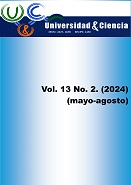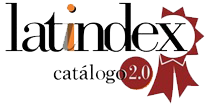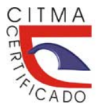Efecto del uso de complementos alimenticios en indicadores productivos de pollonas leghorn L33
DOI:
https://doi.org/10.5281/zenodo.12746782Palavras-chave:
complementos, hidrolizado, microrganismos eficientes, moringa oleífera lam, probióticos, rendimiento, suplementos alimenticiosResumo
Para evaluar el efecto de los complementos alimenticios: Hidrolizado Proteico de Moringa (HPM) y microrganismos eficientes (ME50), para mejorar el comportamiento productivo de pollonas leghorn L33 en desarrollo. Se utilizó un diseño completamente al azar, con tres tratamientos y diez animales en cada uno, de 49 días de edad inicial hasta los 106 días y un peso inicial medio de 310 g. Los tratamientos utilizados fueron: 1) Hidrolizado Proteico de Moringa (30 ml por animal, por día), 2) ME 50 (150 ml por animal, por día) y 3) Sin suplementación alimentaria. Se evaluaron los indicadores peso vivo final, se calculó la ganancia media diaria, y el largo del tarso.El peso final (PF) de los animales que recibieron 30 mL HPM/día, fue superior al de los animales que recibieron 150 mL ME50/día, y ambos tratamientos con PF superiores al grupo control. En la ganancia media diaria (GMD) los mejores resultados se alcanzaron con 30 mL HPM/día (14,37g), seguido de los animales que recibieron 150 mL ME50/día (13,77g), y ambos tratamientos con resultados superiores al grupo sin suplementación. El incremento del tarso fue de 21,7mm y 21,9mm para los tratamientos de 30 mL HPM/día y 150 mL ME50/día respectivamente, sin diferencias entre ellos. se alcanzaron largo del tarso (LT) final significativamente similar de 91,5mm y 92,1mm, tanto para incremento del tarso como para LT final, los resultados de los animales suplementados fueron superior al de los animales que no recibieron suplementación. Se concluye que el uso de complementos alimenticios: HPM y ME50, mejora el comportamiento productivo de pollonas leghorn L33 en desarrollo.
Downloads
Referências
Abdel Rahman, A. N., Amer, S. A., Behairy, A., Younis, E. M., Abdelwarith, A. A., Osman, A., Moustafa, A.A., Davies, S.J., y Ibrahim, R. E. (2023). Using Azadirachta indica protein hydrolysate as a plant protein in Nile tilapia (Oreochromis niloticus) diet: Effects on the growth, economic efficiency, antioxidant‐immune response and resistance to Streptococcus agalactiae. Journal of Animal Physiology and Animal Nutrition. 107(6), 1502-1516. https://doi.org/10.1111/jpn.13857
Ahmad, R., Yu, Y. H., Hsiao, F. S. H., Su, C. H., Liu, H. C., Tobin, I., y Cheng, Y. H. (2022). Influence of heat stress on poultry growth performance, intestinal inflammation, and immune function and potential mitigation by probiotics. Animals, 12(17), 2297. https://doi.org/10.3390/ani12172297
Amer, S. A., Rahman, A. N. A., ElHady, M., Osman, A., Younis, E. M., Abdel-Warith, A. W. A., y Ibrahim, R. E. (2024). Use of moringa protein hydrolysate as a fishmeal replacer in diet of Oreochromis niloticus: effects on growth, digestive enzymes, protein transporters and immune status. Aquaculture, 579, 740202. https://doi.org/10.1016/j.aquaculture.2023.740202
Anee, I. J., Alam, S., Begum, R. A., Shahjahan, R. M., y Khandaker, A. M. (2021). The role of probiotics on animal health and nutrition. The Journal of Basic and Applied Zoology, 82, 1-16. https://doi.org/10.1186/s41936-021-00250-x
Atsbeha, A. T., y Hailu, T. G. (2021). The impact of Effective Microorganisms (EM) on egg quality and laying performance of chickens. International Journal of Food Science, 2021, Article ID 8895717, 8 p. https://doi.org/10.1155/2021/8895717
Báez, R., Hernández, M., y Bello, J. (1998). Pruebas toxicológicas y efecto antitumoral de Bromelina. Revista Cubana de Oncología, 17(3), 37-39.
Bhogoju, S., y Nahashon, S. (2022). Recent advances in probiotic application in animal health and nutrition: A review. Agriculture, 12(2), 304.
Cali Tixi, L. E. (2022). Alimentación con diferentes fuentes de polifenoles en gallinas ponedoras. Escuela Superior Politécnica de Chimborazo. Riobamba. http://dspace.espoch.edu.ec/handle/123456789/17837
Calla, R. R. H. (2018). Inclusión de Moringa Oleífera en dieta y su efecto sobre los parámetros productivos en pollitas Hy Line Brown en Puno. [Trabajo de diploma en opción al título de Médico Veterinario]. Universidad Nacional del Altiplano. Puno, Perú. http://repositorio.unap.edu.pe/bitstream/handle/UNAP/7282/Calla_Ramos_Ra%C3%BAl_Heriberto
Colas Chavez, M., Bernal Mesa, J. D., Támbara, H., Pérez, E. O., y Sánchez Prieto, A. (2017). Contenido de aminoácidos esenciales de un hidrolizado de proteína utilizado como suplemento en dieta de gallinas ponedoras. Revista de Producción Animal, 29(2), 73-76. http://scielo.sld.cu/pdf/rpa/v29n2/rpa10217.pdf
Fazelnia, K., Fakhraei, J., Yarahmadi, H. M., y Amini, K. (2021). Dietary supplementation of potential probiotics Bacillus subtilis, Bacillus licheniformis, and Saccharomyces cerevisiae and synbiotic improves growth performance and immune responses by modulation in intestinal system in broiler chicks challenged with Salmonella Typhimurium. Probiotics and Antimicrobial Proteins, 1-12.
Higa, T., y Parr, J. F. (2013). Microorganismos Benéficos y efectivos para una agricultura y medio ambiente sostenibles. Maryland (USA): Centro internacional de Investigación de Agricultura Natural, Departamento de Agricultura de los Estados Unidos, [archivo PDF]. https://cdn.goconqr.com/uploads/media/pdf_media/42178589/ef577365-1bb5-4922-a61b-1e268f8784d6.pdf
Huang, C., Wang, X., Liang, C., Jiang, X., Yang, G., Xu, J., y Yong, Q. (2019). A sustainable process for procuring biologically active fractions of high-purity xylooligosaccharides and water-soluble lignin from Moso bamboo prehydrolyzate. Biotechnology for Biofuels, 12(1), 1-13. https://doi.org/10.1186/s1306801915273.
Jha, R., Das, R., Oak, S., y Mishra, P. (2020). Probiotics (direct-fed microbes) in poultry nutrition and their effects on nutrient utilization, growth and laying performance, and gut health: a systematic review. Animals (Basel), 10(10),1863. https://doi.org/10.3390/ani10101863.
Liao, S. F., Wang, T., y Regmi, N. (2015). Lysine nutrition in swine and the related monogastric animals: muscle protein biosynthesis and beyond. SpringerPlus, 4, 1-12.
Lin, J., Comi, M., Vera, P., Alessandro, A., Qiu, K., Wang, J., y Zhang, H. J. (2023). Effects of Saccharomyces cerevisiae hydrolysate on growth performance, immunity function, and intestinal health in broilers. Poultry Science, 102(1), 102237.https://doi.org/10.1016/j.psj.2022.102237
Martínez, Y., Li, X., Liu, G., Bin, P., Yan, W., Más, D. M., Hu, C.A., Ren, W., y Yin, Y. (2017). The role of methionine on metabolism, oxidative stress, and diseases. Amino acids, 49, 2091-2098.
Martínez Álvarez, O. (2013). Hormone‐like peptides obtained by marine‐protein hydrolysis and their bioactivities. Marine proteins and peptides: Biological activities and applications, 351-367. https://doi.org/10.1002/9781118375082.ch16
Martínez Álvarez, O., Chamorro, S., y Brenes, A. (2015). Protein hydrolysates from animal processing by-products as a source of bioactive molecules with interest in animal feeding: A review. Food Research International, 73, 204-212. http://dx.doi.org/10.1016/j.foodres.2015.04.005
Montalvo, S. P. (2020). Uso de la moringa (Moringa oleífera) en la alimentación de gallinas de postura. [Trabajo de diploma en opción al título de Bachiller. Universidad Científica. Lima, Perú]. https://repositorio.cientifica.edu.pe/bitstream/handle/20.500.12805/1259/TB-Montalvo%20P.pdf?sequence=1&isAllowed=y
Moreno, O., Montoya, J., Buelvas, L., y Ortiz, O. (2015). Hidrolizados proteicos y perspectivas del modelamiento en cinética enzimática de proteínas: una revisión. Revista Agunkuyâa, 2(1), 64-78. https://revia.areandina.edu.co/index.php/Cc/article/view/303
Oyeyinka, A. T., y Oyeyinka, S. A. (2018). Moringa oleifera as a food fortificant: Recent trends and prospects. Journal of the Saudi Society of Agricultural Sciences, 17(2), 127-136. https://doi.org/10.1016/j.jssas.2016.02.002
Palada, M. C., Ebert, A. W., Yang, R. Y., Chang, L. C., Chang, J., y Wu, D. L. (2017). Progress in research and development of moringa at the World Vegetable Center. Acta Hortic, 1158, 425-434. http://10.17660/ActaHortic.2017.1158.49
Pérez, G. L., Hernández, M. C., Martínez Melo, J., Serrano Torres, J. O., Pérez, M., A., y Mazorra C. C. (2020). Hidrolizado proteico de Moringa oleifera Lam., como suplemento alimenticio en conejos chinchilla en ceba. Revista de Producción Animal, 32(1), 17-29. https://revistas.reduc.edu.cu/index.php/rpa/article/view/e3378
Qorbanpour, M., Fahim, T., Javandel, F., Nosrati, M., Paz, E., Seidavi, A., y Tufarelli, V. (2018). Effect of dietary ginger (Zingiber officinale Roscoe) and multi-strain probiotic on growth and carcass traits, blood biochemistry, immune responses and intestinal microflora in broiler chickens. Animals, 8(7), 117. https://doi.org/10.3390/ani8070117.
Rodríguez Fernández, J. C., Méndez García, V., Calero Herrera, I., Peña Calzada, K., Martos Tejera, D., y Kukurtcu, B. (2016). Evaluation of the nutritional supplement VIUSID vet powder on the productive behaviour of sows and boars. Journal of Environmental Science and Engineering, 5, 432-439. ISSN: 0367-827X https://doi.org/10.17265/2162-5263/2016.09.005.
Samar, A. T., Shimaa, A. A., Ahmed, G., Ali O., Wafaa, R. I. A. S., Amany, I. A., Ghada, I. A. E., Abdel-Wahab, A. A., Elsayed, M. Y., Simon, J. D., y Elshimaa, M. R. (2023) Potential use of cowpea protein hydrolysate as a dietary supplement in broiler chickens: effects on growth, intestinal morphology, muscle lipid profile, and immune status, Italian Journal of Animal Science, 22(1), 1204-1218, https://doi.org/10.1080/1828051X.2023.2274508
Sampath, V., Han, K., y Kim, I. H. (2021). Influence of yeast hydrolysate supplement on growth performance, nutrient digestibility, microflora, gas emission, blood profile, and meat quality in broilers. Journal of Animal Science and Technology, 63(3), 563574.https://doi.org/10.5187/jast.2021.e61
Sharma, M. K., White, D. L., Singh, A. K., Liu, H., Tan, Z., Peng, X., y Kim, W. K. (2022). Effect of dietary supplementation of probiotic Aspergillus niger on performance and cecal microbiota in hy-line W-36 laying hens. Animals, 12(18), 2406. https://doi.org/10.3390/ani12182406
Tao, Y., Wang, T., Huang, C., Lai, C., Ling, Z., Zhou, Y., y Yong, Q. (2021). Production performance, egg quality, plasma biochemical constituents and lipid metabolites of aged laying hens supplemented with incomplete degradation products of galactomannan. Poultry Science, 100(8), 101296. https://doi.org/10.1016/j.psj.2021.101296.
Thuy, N. T., y Ha, N. C. (2017). Effects of inclusion of protein hydrolysis from Tra catfish by-product waste water in the diets on apparent ileal digestibility and total tract retention coefficients of local chickens. Livestock Research for rural development, 29(3). http://www.lrrd.org/lrrd29/3/nthi29055.html
Valdés, A., García, Y., Álvarez, V. M., Samón, A., Pérez, E., Serrano, J. O., Rodríguez, Y y Berenguer, A. (2020). Efecto de microorganismos eficientes, autóctonos de Guantánamo, Cuba, en indicadores bioproductivos y hematológicos de precebas porcinas. Cuban Journal of Agricultural Science, 54(3), 365-373.
Valdivié Navarro, M., Martínez Aguilar, Y., Mesa Fleitas, O., Botello León, A., Hurtado, C. B., y Velázquez Martí, B. (2020). Review of Moringa oleifera as forage meal (leaves plus stems) intended for the feeding of non-ruminant animals. Animal Feed Science and Technology, 260, 114338. https://doi.org/10.1016/j.anifeedsci.2019.114338
Wang, T., Cheng, K., Li, Q., y Wang, T. (2022). Effects of yeast hydrolysate supplementation on intestinal morphology, barrier, and anti-inflammatory functions of broilers. Animal Bioscience, 35(6), 858. https://doi.org/10.5713/ab.21.0374p
Ye, Y., Li, Z., Wang, P., Zhu, B., Zhao, M., Huang, D., Ye, Y., Ding, Z., Li, L., Wan, G., Wu, Q., Song, D., y Tang, Y. (2021). Efectos de los suplementos probióticos sobre el crecimiento y la microbiota intestinal de pollos de engorde de perdiz. PeerJ 9:e12538 http://doi.org/10.7717/peerj.12538
Zambrano, R. A. R., Briones, C. A. R., Chica, H. D. M., Gómez, J. J. A., y Moreira, R. R. Z. (2023). Promotores de crecimiento hematofos B 12 en pollos de engorde. Conocimiento global, 8(2), 28-39.
Downloads
Publicado
Como Citar
Edição
Seção
Licença
Copyright (c) 2024 Universidad & ciencia

Este trabalho está licenciado sob uma licença Creative Commons Attribution-NonCommercial-ShareAlike 4.0 International License.





















